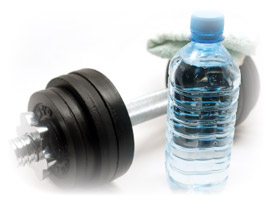Fitness Articles
About this Site l Contact l Free Newsletter l Subscribe to Rss Feed
Recommended Products l Fitness Store l Directly Fitness Blog
Recommended Products l Fitness Store l Directly Fitness Blog
Subscribe
Cardiovascular Exercise: The Benefits and Types


Subscribe.
Share.
Donate.

fitness articles:
Cardiovascular Benefits and Types

Author: Alex Borja
If you've found this website helpful, please click the Donate button. Thanks for the support.
The foundation to getting and staying in shape is a good Cardiovascular workout. As well as its many health benefits, it is proven to help burn body fat to get that lean body most people desire. Cardiovascular training can be any activity that keeps your heart rate elevated for a sustained period of time. During this period your body will burn vast amounts of calories, especially fat, and so it is essential to do Cardiovascular training in order to reduce you body fat %. Some of the Health benefits include:
* Weight loss
* Stronger heart and lungs
* Increased bone density
* Reduced stress
* Temporary relief from depression and anxiety
* More confidence about how you feel and how you look
* Better sleep
* More energy
In addition to these benefits, regular cardio training helps prevent a variety of diseases including heart attack, diabetes, high blood pressure, high cholesterol, and obesity. Types of Cardiovascular training Continuous Aerobic Training (CAT) This type of Cardiovascular training is what you would commonly see people doing in the gym. It consists of exercise at moderate intensity, for usually long periods of time. An example of this would be to run on a treadmill at 75% of your max heart rate for 30 – 45 minutes.
This training is good for beginners as it slowly introduces exercise to the body in order for it to make adaptations. Random (Also known as Fartlek) This type of Cardiovascular training involves random speed play. There are no set times, speeds, or intensity levels preset for this workout. The idea of this type of training is that you will be pushing your body through the different energy systems it uses during exercise in order to cope with the energy demands. For example, a 100 meter sprinter may use the phospho-creatine, and a marathon runner would use the aerobic energy system. Random training will take you into both of these energy systems as well as the lactic energy system which is anaerobic (Does not use oxygen) Intervals Interval training is carried out at a much higher intensity, pushing your body to the limit.
During interval training you should be aiming for about 80-95% of your max heart rate. Some advance interval training (Expletives and cruise training) may even go as high as 100%, so you are working as hard as you possibly can. The principle of this training is to have a work and rest phase. The work phase is where your body is pushed all out, and the resting phase is where the body has chance to recuperate for the next interval. It has been proven to burn more calories than continuous aerobic training due to the body's metabolism constantly spiking. Also, because of the high intensities reached during this training, the body becomes fatigued at a much faster pace, so interval training can only be sustained for usually 20-30 minutes.
Overall, Interval training is one of the most effective fat burning workouts, due to the high intensities reached in such small times. How it can be done Cardiovascular training can be done many ways. Outside of the gym it can be done by running, walking, cycling, swimming, etc. In the gym it can be done on a treadmill, rowing machine, bicycle, cross trainer, stepper, etc.
Choose a machine suitable for the type of cardiovascular training. For example don't choose a treadmill if you plan to do high intensity intervals, as there is a risk involved when changing between the work/rest phases at high speeds.
Choose a machine that is right for your fitness level. If you prefer a low impact machine, something that will be light stress on the joints, then choose a Cross trainer rather than a treadmill. Introduce some interval training in your next workout and see how many more calories you burn.
Trev Flowers Sprint Personal TrainingArticle Source:articlesbase.com/weight-loss-articles/cardiovascular-exercise-the-benefits-and-types-of-training-2041333
Read through more fitness articles: Fitness Articles Home
Like the site? Sign up for the FREE newsletter. I'll send a new article once or twice a month. Unsubscribe
anytime.
anytime.


